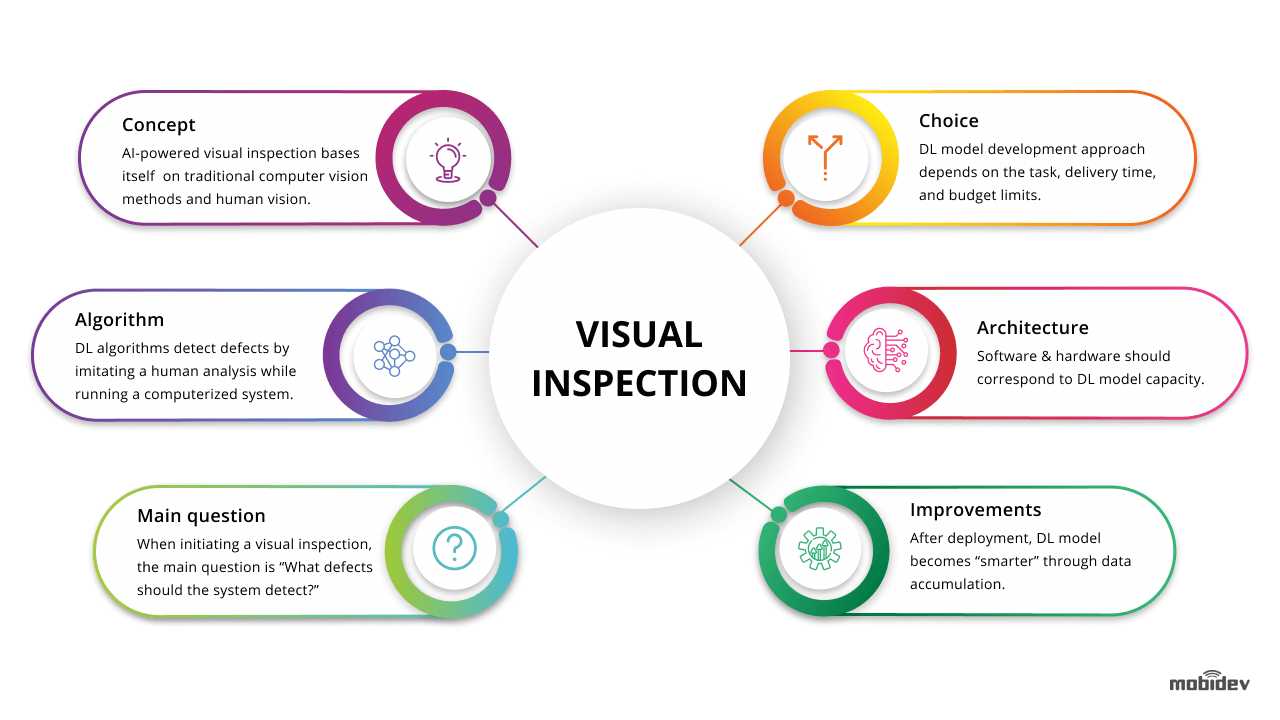The main role of defect detection systems is to distinguish between critical defects that render a product unusable and non-critical defects that fall within the manufacturer’s acceptable standards. Thanks to its advanced capabilities in image processing and pattern recognition, AI technology can contribute to these detection systems. However, to accomplish this, the automated visual inspection process must take into account various factors. Let’s talk about them in more detail to find out how to use AI for defect detection tasks in the manufacturing industry.
Deep Learning Capabilities for Visual Inspection
AI-based defect detection systems utilize deep learning techniques, enabling machines to learn from vast amounts of data. The initial training process establishes the foundational logic, and AI engineers can continuously enhance the performance of deep neural networks by incorporating new data.
By training a neural network with labeled examples, you can teach the system to recognize common patterns within the data. This way AI inspection systems can effectively identify parts, anomalies, and characteristics just like a human conducts a visual inspection in manufacturing.
Data is Key for AI-Powered Defect Detection
When building defect detection software for a manufacturing line, the first step is to choose a suitable deep-learning model architecture that addresses the specific issue at hand. Subsequently, the model should be trained using examples of both defective products and defect-free normal products.
Having a sufficient amount of relevant data is crucial for developing effective AI defect detection software. The responsibility of gathering datasets typically falls upon the manufacturer. The collected data should align with the tasks assigned to the AI inspection system and encompass the parameters of the production process. Ideally, the data should be collected from the same production line and under the same conditions in which the defect detection software will be deployed.
Following the initial deployment of the automated visual inspection system, additional data can be gathered later. This new data will be used to improve the performance of the model, thereby enhancing the accuracy of the defect detection process.
The Process of Developing an AI Defect Detection System
The development and implementation of an AI defect detection system can be divided into several stages.

Source: MobiDev’s AI Visual Inspection Guide
- Business Analysis Stage: This includes identifying the specific business problem that the visual inspection software will address. You can also assess the potential business value of implementing AI-based defect detection by analyzing the available data.
- Deep Learning Method Selection Stage: At this stage, a decision is made regarding the selection of a deep learning model architecture. The choice depends on factors such as the complexity of the task, desired delivery time, and budget constraints.
As a result, you can start using pre-trained models and adapt them to your business needs or you will need to create a custom model if the possibilities of ready-made solutions are not sufficient for your case.
- Data gathering: Artificial intelligence engineers, together with the business owner, take on the task of collecting and preparing the necessary data for training.
- Data labeling: Specialists assign informative tags to each piece of collected data, including defect presence and type. The labeled data is used for training the model.
- Model training: This involves splitting the dataset into training, validation, and testing datasets. Then AI professionals compare the target and predicted results evaluating the model performance.
- Deployment: This step requires matching the software and hardware architectures with the capabilities of the trained model. The specific devices needed for integration may vary depending on the industry and automation processes (cameras, portable devices, drones, etc.)
Final Thoughts
Implemented correctly and with relevant data, AI defect detection systems provide superior accuracy and consistency compared to manual inspection, resulting in improved product quality and reduced defects. These systems also enhance productivity by automating the inspection process, enabling real-time detection, and optimizing resource allocation.
However, it’s worth remembering that AI is a complex technology, and setting up AI defect detection requires specialized skills and knowledge. That’s why working with a development team that has previous experience building AI visual control systems is critical to the success of your project.






